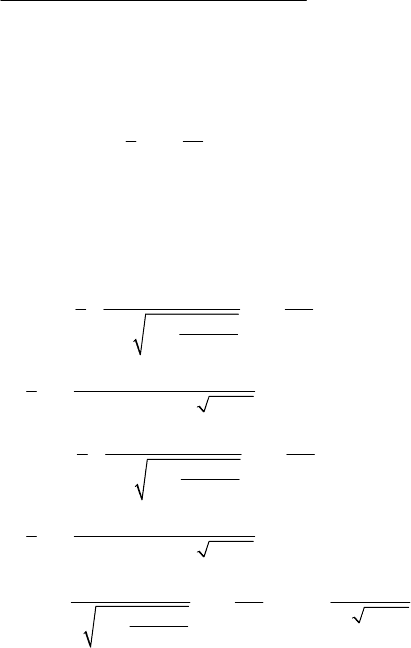Teodorescu P.P. Mechanical Systems, Volume III: Analytical Mechanics
Подождите немного. Документ загружается.


MECHANICAL SYSTEMS, CLASSICAL MODELS
382
then, we can write
()
()
()
()
()
() ()
()
()()
()
()
11
111
δ=⋅δ−⋅−⋅δ−⋅δ−⋅δ−δ
′
=⋅δ− ⋅ ⋅δ−δ−⋅δ− ⋅δ
′
−⋅ ⋅δ−δ−⋅δ− ⋅δ−δ
′
δ = ⋅δ − ⋅ ⋅ δ −δ − ⋅ δ − ⋅δ
−⋅ ⋅δ−δ−⋅
vpvv vvvr v r r
r
vp vv r r vv vv
r
vr r r vr v r r
r
v p vv r r vv v v
r
vr r r v
2
11112 121 121
11 12 2 1 12 12
1211121
2
22212 2112 21
22 21 2
d
,
r
r
r
mc l l
r
lll
r
mc
r
l
r
μμ
μμμ
μμμ
()
22
′
δ− δ−δ
rvrr
22 1
,ll
as well as
()
()
()
()
′
δ= ⋅δ−δ+δ
′
δ= ⋅δ−δ+δ
r
rr
r
rr
22 2
21
22 2
21
,
,
r
r
cc c
r
cc c
r
μμ μ
νν ν
where the label
r indicates the differentiation with respect to this argument, while
′
δ
indicates the variation with to the other arguments. Hence, for the energy (21.3.46) we
obtain
[
{()
()
}( )
()
()( )
δ= ⋅δ+ ⋅δ
−⋅++ ⋅− +
⎤
⎦
′
++ ⋅δ−δ+ −⋅δ
′′ ′
−δ ⋅ = δ + δ ⋅ + δ
vpvp
r
vv v v r
vv rr vv
vv v v r
1122
2
12 1122
2
11 22 2 1 1 2
2
12 11 22
22
2
2.
rrr
rr
H
ll c
r
ll c
ll c
μμν
μ
μν
(21.3.47)
Applying the Principle 21.3.1 in the form (21.2.41') and taking into account
(21.3.47), we can write
()
() ( )
⋅
⎛⎞⎛⎞
′
−⋅δ+ −⋅δ+ − δ
⎜⎟⎜⎟
⎝⎠⎝⎠
′′′
−δ ⋅ + δ − δ + δ ⋅ − δ=
pp vv
Lr Lr
vv v v r
12 12
2
12
2
2
12 11 22
dd
21
dd
d
20,
d
c
tt
c
H
cll t
t
μ
μν
(21.3.48)
with
()
()()
12
22
11 22 1 1 2 2
2
21 2 .
rr
rr
ccllll
r
c
μν
⋅
⎡⎤
=− +−+⋅−+
⎢⎥
⎣⎦
vv
r
Lvvrvv
(21.3.48')
The equations of motion are thus obtained in the form
==−==
pp
LL
12
0
dd
,, const
dd
HH
tt
.
(21.3.49)

Other Considerations on Analytical Methods in Dynamics of Discrete Mechanical Systems
383
In a Newtonian language,
L and −L correspond to the internal forces which act upon
the two particles
1
P and
2
P , respectively. Taking into account (21.3.46), the condition
of conservation of the energy
H
leads to a relation of conservation of mass
+++=++ +
00
00
12 1 2
22 2 2mm m mμν μ ν,
(21.3.50)
formed by the individual masses
1
m and
2
m , the mass of gravitational interaction μ
and the mass of dilatational interaction
ν .
Separating the terms which contain the mass
μ in the relation (21.3.48), we can
write
()
()
⋅
′′
−δ=δ⋅
vv
vv
12
2
12
2
21c
c
μμ
,
(21.3.51)
where we took into account that the scalar product
⋅vv
12
does not depend on r ;
writing this relation in the form
(
)
⋅
′
δ
′
δ
=
⋅
−
vv
vv
12
2
12
2
1
2
1
c
c
μ
μ
,
we get
=
⋅
−
vv
12
2
()
1
r
c
ϕ
μ
,
(21.3.52)
where
()rϕ is a function which remains to be determined. Taking into account
(21.3.45), this function will be of the form
⎡
⎤
=− +
⎢
⎥
⎣
⎦
00
12
22
()
1
() 1
2
r
mm
rf
cr c
λ
ϕ
,
(21.3.52')
the function
()rλ being obtained by considering a particular motion. In case of usual
distances and velocities one can take
=−
00
12
2
1
2
mm
f
cr
μ
,
(21.3.53)
the respective energy being the potential energy
−
00
12
/fm m r of the Newtonian
modelling. The terrestrial experience and that concerning the solar system of our
Galaxy show that the mass
ν can be neglected; we can write, with a good
approximation,

MECHANICAL SYSTEMS, CLASSICAL MODELS
384
()
=+
=+
=++
pvv
pvv
111 2
222 1
2
12
,
,
2,
m
m
Hcm m
μ
μ
μ
(21.3.54)
the equations of motion being (21.3.49), with
()
⋅
=−
vv
r
L
12
2
2
21
r
c
r
c
μ
.
(21.3.54')
Choosing
==() /, constrkrkλ , we can also write
()
=− +
⋅
−
vv
00
12
2
12
2
2
1
1
2
1
mm
k
f
cr
cr
c
μ
.
(21.3.54'')
Once
μ is determined, the condition (21.3.48) leads to
()
′′′
δ= δ+δ ⋅vv r
2
11 22
2cllν ,
(21.3.55)
where
′′′′′′
δ=δ+δ δ=δ+δ
11 122 2
,lh hlh hνν νν ;
(21.3.55')
we can also write
()()
′′
′
+⋅ δ+δ⋅
δ
⎡⎤
−=
⎢⎥
⎣⎦
vvr v v r
11 22 1 1 2 2
22
1
22
hh h h
cc
ν
ν
.
This equation can be integrated in the form
()
+⋅
==
−
vvr
11 22
2
()
,
1
2
r
hh
u
u
c
ψ
ν
,
(21.3.56)
if we choose
=⋅=⋅vr vr
111 222
() , ()hrhrψψ,
(21.3.56')
Putting
==
++
00
12
12
00 00
22
12 12
11
() , ()
mm
rr
mm mm
rr
ψψ
,
(21.3.56'')
we can write

Other Considerations on Analytical Methods in Dynamics of Discrete Mechanical Systems
385
()
+
=
+
vr vr
02 2 02 2
11 1 22 2
002
12
cos( ,) cos( , )
2
mv mv
u
mmc
(21.3.56''')
too, so that we have
≤ 1u , being led to a real value for ν . We notice that ν is
negligible for infragalactic distances; we impose thus
()
=−
2
12
2
1
()
2
r
rgl
c
ψ
,
(21.3.56
IV
)
where
g is a universal constant,
12
l being a characteristic parameter of the two particles
in interaction.
In conclusion, in the frame of the invariantive model of mechanics we can write
()
()
()
()
=− +
⋅
−
−
+−
=− +
⋅
−
−
+−
v
pv
vv
vr
r
v
pv
vv
vr
r
00
122
111
2
12
2
2
0
11 1
12
004
12
00
121
222
2
12
2
2
0
22 2
12
004
12
1
1
2
1
cos( , )
1
,
2
1
1
1
2
1
cos( , )
1
,
2
1
mm
k
mf
cr
cr
c
rm v
gl
mmc u
mm
k
mf
cr
cr
c
rm v
gl
mmc u
(21.3.57)
()
()
=+− +−
⋅
−
−
vv
00
2
12
2
12 12
22
12
2
1
1
1
mm
kr
Hcm m f gl
cr c u
r
c
.
(21.3.57')
These results allow to pass to the study of a discrete mechanical system (system of
particles), as well as to the study of a continuous mechanical system.
21.3.3 Applications
We apply the results thus obtained to the study of some problems of celestial
mechanics, making – with this occasion – also some specifications concerning the
functions introduced and their mechanical interpretation; we consider thus the problem
of dilatation of the Universe (Hubble’s law) and the problem of secular motion of the
perihelion of Mercury.
21.3.3.1 Dilatation of the Universe. Hubble’s Law
Let be the system formed by two particles
1
P and
2
P , considered in Sect. 21.3.2.3;
starting from (21.3.44), the conservation of the momentum of this system leads to
+++++ ==vvvv rC
11 22 1 2 1 2
()() constmm hhμν
J
JJJJG
.
(21.3.58)

MECHANICAL SYSTEMS, CLASSICAL MODELS
386
A scalar product by
r , where we take into account (21.3.56'), (21.3.56''), we denote
cos( , ), 1,2
j
jj
vjξ ==vr , and divide by r , leads to
+
++++ = =
+
Cr
1
00
122
11 22 1 2
00
12
() cos(,)
mm
mm C
mm
ξξ
ξξμξξ ν Γ
.
Assuming that
+≠
11 22
0mmξξ, dividing by this sum and using the relations
(21.3.54''), (21.3.56), (21.3.56
IV
), we obtain the equation
′′′′
++ + =
+
2
2424
11 22
111
1 MMNr
mm
cr cr c
Γ
ξξ
,
(21.3.59)
where
+
′′′′
=− =
⋅
+
−
+
′
=−
+
−
+
vv
00
12 1 2
12
11 22
2
00
2
12 11 22
00
11 22
12
1
,,
2
1
1
,
2
1
mm
Mf MkM
mm
r
c
lmm
r
Ng
mm
u
mm
ξξ
ξξ
ξξ
ξξ
(21.3.59')
()
+
=
+
12
02 00
12
002
12
2
mm
u
mmc
ξξ
;
(21.3.59'')
denoting, further,
′′′
==
−−
++
′
=
−
+
12
11 22 11 22
11 22
,,
11
,
1
MM
MM
mm mm
N
N
mm
ΓΓ
ξξ ξξ
Γ
ξξ
(21.3.60)
it results the equation
++=
2
12
2424
11
1
r
MMN
cr cr c
.
(21.3.60')
Differentiating with respect to
t and dividing by
4
(2 / )rc N, we get
⋅⋅⋅
−+−++=
rr rr rr
22
11 22
23 34
11
0
2
22 2
MM MM
cc rN
NNr NNrNr
rr rr
or

Other Considerations on Analytical Methods in Dynamics of Discrete Mechanical Systems
387
⋅
⎛⎞
⎛⎞
−− =−+−
⎜⎟
⎜⎟
⎝⎠
⎝⎠
rr
22
12 12
34 34
11
11
2
22
MM MM
crNc
NNr N
rr rr
NN
.
Observing that
⋅
== =− =−
rr
vr vr
22 11 21
cos( , ) cos( , )wv v
r
ξξ
(21.3.61)
represents the relative velocity of the particles, the preceding relation leads to
++
=
−−
2
12
34
2
12
34
1
1
1
2
1
1
MM
c
N
rr
NN
wr
N
MM
c
NN
rr
;
(21.3.61')
this constitutes an exact law of mechanics of an isolated system formed by two particles
in inertial motion.
Let be two galaxies, the relative motion of which will be considered in a particle
modelling, by means of the results obtained above. In the hypothesis
+≠
11 22
0mmξξ
and
+≠
12
00
12
0mmξξ, we will consider galaxies for which there exists
<<,0 1KK
,
so that
+< + < +
+< + < +
12 1 2 12
12 1122 12
0000 00
12
() (),
() ().
Kc m m m m c m m
Kcmmmm cmm
ξξ
ξξ
(21.3.62)
Assuming that
≤ (9/10)
j
vc and supposing that the accelerations =,, 1,2
jj
vjξ
, are
sufficiently small, O. Onicescu finds, with a good approximation, the formula
≅
1
2
N
w
N
,
(21.3.61'')
where the ratio
/NN
does not depend on r , being approximately constant. It results
thus a law which corresponds to Hubble’s law, obtained on an empirical way for
ultragalactic distances.
Considering the energy
H given by (21.3.57'), we observe that the last two terms can be
interpreted as potentials; for usual velocities, the first one is the Newtonian gravitational
potential and the second one is an elastic potential, in that concerns the dependence on
r .
Hence, “between two bodies (two particles) of the Universe are exerted two forces of
inertial interaction: a force of reciprocal attraction (gravitational), the principal part of which
is in inverse proportion to the square of the distance, and an elastic repulsive force, in direct
proportion with the distance, very small (even at distances of planetary order)”. Especially,
to this latter force is due Hubble’s effect mentioned above.
Thus, the invariantive model of mechanics puts in evidence the dilatation of the
Universe, as well as the fact that it is finite. The ratio
/NN
can be positive or

MECHANICAL SYSTEMS, CLASSICAL MODELS
388
negative, so that, during the dilatation can take place also oscillatory phenomena. One
can make many interesting considerations in this order of ideas too.
21.3.3.2 Secular Motion of the Perihelion of Mercury
Let be the Sun and a planet which will be modeled as two particles, by means of the
results in Sect. 21.2.3.3; neglecting the mass of dilatational interaction
ν , we will use
the equation of motion (21.3.49), (21.3.54'), the momenta being given by (21.3.54).
To obtain the equations of motion of the planet with respect to the Sun, we choose a
preferential frame of reference; we consider thus the point of position vector
+++
=
++
rr
1122
12
()()
2
mm
mm
μμ
μ
ρ .
(21.3.63)
Taking into account the law of conservation of energy
=++
2
12
(2)Hcm m μ
= const , the relation (21.3.54) and =−rr r
12
, it results
++
=+
++ ++
pp
r
12 2
12 12
22
m
mm mm
μ
μμ
ρ
.
(21.3.63')
Remaining to the terms in
22
1
/vc and
22
2
/vc and assuming that < r
00 22
21
/||/mm c
for the majority of the planets, we find
=
0
μμ, so that
+
=
++
pp
12
0
12
2mm μ
ρ ;
(21.3.64)
hence, the frame of reference with the origin at the point of position vector
ρ
is, in the
limits of the considered approximation, an inertial frame.
Evaluating
⋅⋅ ⋅
−≅− ≅+
⋅
−
vv vv vv
vv
12 12 12
22 2
12
2
1
11, 1
22
1
cc c
c
and taking
=
0
μμ, we can write the equation of motion (21.3.49), (21.3.54') in the
form
()()
()()
⋅
⎡⎛ ⎞ ⎤
++= − +
⎜⎟
⎢⎥
⎣⎝ ⎠ ⎦
⋅
⎡⎛ ⎞ ⎤
++=− − +
⎜⎟
⎢⎥
⎣⎝ ⎠ ⎦
rr
r
rr
rr
r
rr
200
11212
0
0
11 2
2222
200
21212
0
0
12 1
2222
d1 1 2
111,
d2 2
d1 1 2
111.
d2 2
rmm
k
mf
tr
crccr
rmm
k
mf
tr
crccr
μ
μ
Passing to the above inertial frame, the position vectors
1
ρ
and
2
ρ
verify the relations

Other Considerations on Analytical Methods in Dynamics of Discrete Mechanical Systems
389
+++=
+++=
+=+
00
1122
00
1122
00
1122
()(),
()(),
()();
mm
mm
mm
μμ
μμ
μρ μρ
0
0
ρρ
ρρ
(21.3.65)
in this frame, the equations of motion become
()
()
⎛⎞
⎡⎛ ⎞⎤
++ = + +
⎜⎟
⎜⎟
⎢⎥
⎣⎝ ⎠⎦
⎝⎠
⎛⎞
⎡⎛ ⎞⎤
++ =− + +
⎜⎟
⎜⎟
⎢⎥
⎣⎝ ⎠⎦
⎝⎠
r
r
1
2
2
20 0 0
11 2 1
1
0
22 2 2 2
2
2
20 0 0
22 1 2
2
0
22 2 2 2
1
d11 1 2
111,
d22 2
d11 1 2
111.
d22 2
fm fm m
k
tr
m
ccr r c cr
fm fm m
k
tr
m
ccr r c cr
ρ
ρ
ρ
ρ
ρ
ρ
(21.3.66)
Retaining the terms of second order in r
22
||/c
, after subtracting the equations
(21.3.66) and after some calculations, one obtains
()
()
+
⎛⎞
=− − +
⎜⎟
⎝⎠
rr
r
00
2
12
222
32
11
2
fm m
k
r
rccr
(21.3.67)
or, taking into account the admitted approximation,
()
+
⎛⎞
=− + −
⎜⎟
⎝⎠
rr
r
00
2
12
222
23
1
2
fm m
k
r
rcrc
.
(21.3.67')
The corresponding motion is, obviously, plane, taking place under the action of the
Newtonian force in the relative motion and of the perturbing force
()
+
⎛⎞
−−
⎜⎟
⎝⎠
rr
00
2
12
222
23
2
fm m
k
r
rcrc
.
(21.3.67'')
The perturbing force being small, one obtains – in a first approximation – an elliptic
orbit. The action of the perturbing force leads to a perturbation in the elliptic motion;
thus, the motion of the perihelion can be studied by the method of the variation of the
constants.
Comparing with the known results concerning the secular motion of the perihelion of
Mercury (the deviation is the greatest for this planet), I. Mihăilă, who has studied the
problem in an invariantive modelling, obtains
()
=+
00
12
9
2
kfmm
;
(21.3.68)
hence,
()
+
=
00
12
9
()
2
fm m
r
r
λ .
(21.3.68')

MECHANICAL SYSTEMS, CLASSICAL MODELS
390
The mass of gravitational interaction introduced in Sect. 21.3.2.3 will thus have the
expression
()
+
⎡
⎤
=− +
⎢
⎥
⋅
⎣
⎦
−
vv
00
00
12
12
2
12
2
2
19
1
22
1
fm m
fm m
cr
cr
c
μ .
(21.3.69)
21.4 Formalisms in the Dynamics of Mechanical Systems
In general, there are not searched methods of study for particular dynamical
problems, but methods of study for classes as large as possible of such problems; thus,
Lagrange’s equations and Hamilton’s equations, applicable to the study of the motion
of many discrete and continuous mechanical systems, have been introduced. In this
case, starting from a physical concept, one obtains a final formula, through the agency
of a geometric image of a discrete mechanical system, that is a representative point in a
representative space; a geometric intuition can lead to the choice of a representative
space, the most adequate to the considered problem. Starting from the space
3n
E , one
obtains thus the space
s
Λ and then space
2s
Γ , hence the configuration space ()q and
the phase space
(, )qp , respectively, where we have put in evidence the generalized
co-ordinates and the generalized momenta. It is convenient, in some cases, to use
formalisms of calculation in spaces with
+ 1s dimensions (the space (,)qt or the
space
(, )pH ) or in spaces with +21s or with +22s dimensions (the space (,, )qtp
or the space
(,, , )qtpH , respectively).
In what follows we present some results concerning these formalisms. As well, we
will give some notions concerning the inverse problem of Newtonian mechanics and the
Birkhoffian formalism (Birkhoff, G.D., 1927; Obădeanu, V., 1987; Sabatier, P.C.,
1978; Synge, J.L., 1960).
21.4.1 Formalisms in Spaces with + 1s Dimensions
A space with + 1s dimensions can be of the form (,)qt or of the form (, )pH ; in
what follows, we put in evidence the connection between these spaces too.
21.4.1.1 Description of the Motion of a Mechanical System in the Space of the
Events
(,)qt
The most simple representative space is – obviously – the space ()q ; however, the
image of all the trajectories is not very simple, because a trajectory which passes
through the representative point
P
is determined not only by the direction
12
d , d ,...,d
s
qq q at this point. If the given forces are conservative (e.g., gravitational
forces), then to a given direction at
P corresponds a simple infinity of trajectories; in
case of non-conservative forces there exists a double infinity of trajectories. In the
space
(,)qt , which we call the space of events, it is easier to put in evidence the totality

Other Considerations on Analytical Methods in Dynamics of Discrete Mechanical Systems
391
of the trajectories; indeed, in this space a trajectory which passes through the point
P
is completely determined by the quantities
12
d ,d ,...,d
s
qq q and dt , which specify the
direction. Moreover, this affirmation can be made even if the given forces are not
conservative.
From reasons of homogeneity, it is convenient to denote
+
== =
1
, 1,2,..., ,
jj
s
xqj s x t,
(21.4.1)
in the space
(,)qt . Let be, in this space, a curve C of equations = ()xxu
αα
,
=+1,2,..., 1sα ; we assume that these functions of class
2
C are smooth, so that the
derivatives
′
=
d/dxxt
αα
cannot be simultaneous zero for the same value of u . The
curve
C
, with a determined sense but without a special parameterization, is a geometric
object which corresponds to a possible motion of the mechanical system.
We introduce a function of Lagrange type
+
′
≡
12 1
( , ) ( , ,...., ,
s
xx x x xΛΛ
+
′′ ′ ′
≡
12 1
, ,..., ) ( , )
s
xx x x x
αα
Λ (in the space (,)qt we use the Greek indices, which take
values from
+1to 1s
in the corresponding condition of summation), which we
assume to be positive and homogeneous of first degree in the derivatives
′
x
α
, so that
∂
′′′
=>=
′
∂
(, ) (, ), 0,xkx k xx k x
x
α
α
Λ
ΛΛ Λ
,
(21.4.2)
the last relation corresponding to Euler’s theorem; in what concerns the smoothness, we
assume the existence and the continuity of any derivative which intervenes. We have
the relation of invariance
′′
=
(, ) (, )xx xxΛΛ by a change of co-ordinates
′′
→(, ) (, )xx xx
.
The Lagrangian action on the curve C from =
1
uu to =
2
uu is given by
′
=
∫
2
1
() (, )d
u
u
Cxxu
Λ
ΛA
,
(21.4.3)
so that ()C
Λ
A
is a functional of the curve C , independent of the parameterization
(due to the homogeneity). The elementary Lagrangian action is
′
=d(,)d (,d)xx u x x
Λ
Λ
A
; thus, the space of the events becomes a Finsler space. If
(,d)xxΛ is the square root of a homogeneous quadratic form in differentials, then the
space
(,)qt is a Riemannian space.
Choosing
=ut, we can define Lagrange’s function (;;)qtqL by
==
12 12 12 12
( , ,..., ; ; , ,..., ) ( , ,..., ; ; , ,..., ,1)
ss ss
qq qtqq q qq qtqq qΛ L ,
(21.4.4)
the elementary Lagrangian action being
=d(;;)dqtq t
L
A
L .
Let us pass, by a synchronous variation
δ , from the curve C to a curve
C
, so that
